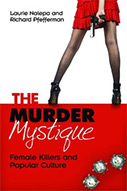The Murder Mystique: Female Killers and Pop Culture

Authors: Laurie Nalepo and Richard Pfefferman
Publisher: Santa Barbara, CA: Praeger, 2013. 177p.
Reviewer: Jaclyn Schildkraut | November 2013
Many people, in far greater numbers than the cases and percentages would seem to warrant, are both fascinated and repelled by the idea of female killers — those women who account for approximately 10% of all murders committed. For some reason, the killings that these women commit draw and hold the public’s attention in way that a “regular” male murderer‘s violence does not. In their book The Murder Mystique: Female Killers and Popular Culture, authors Laurie Nalepa and Richard Pfefferman explore, through a collection of in-depth case studies of five major motives, how and why this happens.
The public’s perception of a female murderer usually puts her into one of two categories: she is seen either as a sympathetic victim trapped in and faced with a situation that, to her, had no way out other than murder, or she is perceived as a cold-blooded killer. There is virtually nothing in between. While there are many variations on the main themes, the authors have chosen to examine ten cases related to the motives of love, money, revenge, self-defense, and psychopathology. Describing in minute detail cases that occurred between 1955 and 2010, the authors compare and contrast two women representing each of these main motive groupings, delving into the circumstances of their lives prior to the actual murders taking place, the aftermath, the punishments, and just why these women attract so much scrutiny and intense interest.
The cases chosen to represent each of the five motives feature protagonists, who often not only differ from each other physically, but also in most other comparable areas of their lives (such is the case with Francine Hughes and Liysa Northon, who are featured in the section about “Women Who Kill in Self Defense”). One, Liysa, is incredibly beautiful, wealthy, ensconced in the upper levels of society, while the other, Francine, is almost typecast as “everywoman” – so ordinary she could almost be any one of us reading the book. She is not glamorous, or financially secure, or possessing almost any of the other positive attributes to which many of us aspire. And yet, her very being resonated with the judge and the jury and she was judged “not guilty” in the courtroom even though she had admitted to killing her husband by setting the bedroom on fire while he slept. A television movie, “The Burning Bed” starring Farrah Fawcett as Francine, was based on this case. Liysa, on the other hand, who was thought to be lying because the evidence contradicted her statements and who very well might have been convicted had the case gone to court, decided to take a plea deal for first-degree manslaughter and a term of 12-1/2 years in jail, less than a week before her court date.
There also are similarities and differences between the murderesses featured in the other four sections of the book as well, and all are intriguing looks at a type of person most of us will never have contact with in our lives. The authors, in addition to the great detail about the women themselves, also provide a rich detailing of the social and cultural happenings over time, including the different phases of the Women’s Movement in this country and the metamorphosis that that phenomenon has undergone. The book details as well how changing and evolving societal mores, including media, movies, sexuality, gender relations, and criminal violence impacted these women and the outcomes of their crimes.
Jaclyn Schildkraut, Professor at Texas State University School of Criminal Justice


